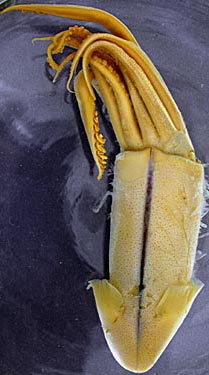


Figure. Illustrations of the holotype of Walvisteuthis rancureli. Left - Dorsal view. Right - Ventral view. Photographs by R. Young.
Introduction
Okutani described Onykia rancureli primarily from four squid taken from the stomach of a lancet fish (Alepisaurus ferox) caught in the tropical Indian Ocean. He examined additional material from over the South Pacific as well and considered it the same species as the type series. He also considered that specimens described as Onykia sp. Rancurel (1970) from fish stomachs belonged to this species. The species described by Okutani was so different from other species of Onykia that the minor differences seen among the specimens he examined, presumably, were considered unimportant. The following description is mostly taken from the original but clarifications based on the examination of the holotype are included.
Description
- Arms
- Arms with broad dorsal protective membranes and long trabeculae (see arrows).
- Ventral protective membranes and trabeculae short.
- Suckers lack distal fleshy swelling.
- Tentacle
- Stalk with a aboral carina.
- Carpal locking apparatus with 9 suckers.
- Club with two series of hooks: 25 hooks on the left club and 24 on the right. The apparent single series in the drawing to the left is an artifact of the poor condition of the club.
- Largest hooks in ventral series on club are numbers 4 and 5 from the proximal end.
- The terminal pad has seven to nine small suckers.
- A few marginal suckers are present proximally on the club on either side.
- Head
- In the type series, the number of occipital folds is unclear but at least two are present on the holotype.
- Beaks
- Upper beak with an acute jaw angle; hood "moderately" apart from the crest; rostrum gently curves.
- Lower beak with "moderately" distinct wing fold hides obtuse jaw angle; hood short and close to crest; crest narrow; lateral wall ridge extends halfway between crest and inner posterior corner.
- Radula
- Lateral tooth 2 is smaller than the rhachidian or lateral tooth 1. The unusual radula (see below) was not available for us to check.
- Funnel
- Funnel groove without typical V-shape. Presumably this is an artifact resulting from the squid's residence in the stomach of its predator.
- Gladius
- Minute, cap-like rostrum.
- Widest point two thirds GL from anterior end.
- Measurements


Figure. Dorsal view of mid-region of arms II and III of W. rancureli, holotype. The shape of the horny rings of the suckers was completely destroyed apparently by the stomach acid of the predator. White arrows point to trabeculae of the protective membrane. Photograph by R. Young.



Figure. Oral views of tentacular club of W. rancureli. Top - Drawing from Okutani, 1981. Bottom - Photograph by R. Young of the holotype.Very little remains of the shape or precise size of the hooks due, apparently to the stomach acid of the predator.
| Holotype | Paratype | Paratype | |
|---|---|---|---|
| Sex | F | F | F |
| ML, mm | 68 | 43.5 | 57.6 |
| MW, % ML | 42.5 | 48.5 | 41.7 |
| Head W, % ML | 36.8 | 40.0 | 35.6 |
| Fin L, % ML | 47.1 | 38.4 | 46.9 |
| Fin W, % ML | 105.3 | 97.5 | 100.2 |
| Arm I, % ML | 72.4 | 52.9 | 67.7 |
| Arm II, % ML | 86.5 | 69.0 | 78.8 |
| Arm III, % ML | 90.0 | 69.9 | 81.6 |
| Arm IV, % ML | 82.2 | - | 77.4 |
| Club L, % ML | 42.6 | 39.5 | 42.2 |
Comments
The lateral tooth 2 on the radula is the smallest tooth in Okutani's material but ranks second in size in Rancurel's 1970 description of W. rancureli (his Onykia sp.) from the South Pacific. The radula illustrated by Rancurel is very similar to that of W. youngorum from Hawaiian waters.


Figure. Radula of W. rancureli. Drawing from Rancurel, 1970.
Okutani (1981) states that the holotype is a female. We were unable to identify nidamental glands or a penis.
Distribution
The type locality is a fish captured at 07°51'S, 88°02.5'E in the tropical central Indian Ocean. Other squid in the type series came from fish captured at 09°15'S, 83°45'E, 09°21'S, 81°42'E, 11°16.2'S, 109°29.5'E in the tropical central and eastern Indian Ocean.








 Go to quick links
Go to quick search
Go to navigation for this section of the ToL site
Go to detailed links for the ToL site
Go to quick links
Go to quick search
Go to navigation for this section of the ToL site
Go to detailed links for the ToL site